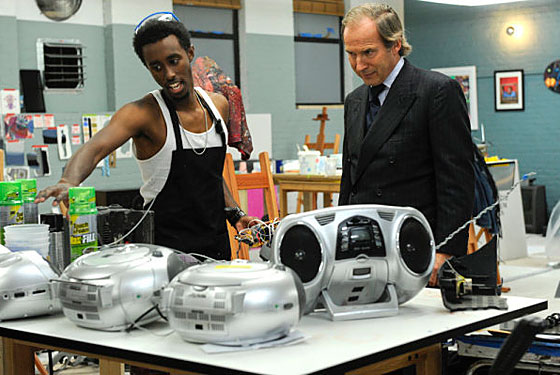
I have to tell you a little something about how they actually shoot these shows. A one-hour episode of reality TV can take as long as sixteen hours to film. The shots where judges like myself give mean looks to the artists before pronouncing decisions on their work last something like three seconds onscreen, but require fifteen minutes of us all staring at one another. (The cameras have to be moved around and positioned so each person can be filmed.) I kept having weird retinal pops and glitches during these endurance staring contests. I think Nao hypnotized me during one of them.
Anyway, on this week’s challenge: making art from junk.
Process
After the artists were asked to make a sculpture out of materials gathered from what the show called “an appliance graveyard,” (actually a junk warehouse a few blocks from where the show was shot in the West 40s) we watched them run around grabbing TV sets, appliances, and electrical wire, throwing all it into rolling carts. I was amazed that Miles picked that moment to curl up and try to sleep — it seemed very Warholian to me that he was making fun of the competition. Ditto Nao, who asked aloud, “Who am I? Where am I? What am I doing here?” That’s how I felt at the beginning of this episode as well. I thought viewers would be totally bored by the sight of artists caulking glass, sawing wood, untangling wire, and waiting for paint to dry. Then a quiet, satisfied feeling crept in: I love watching people make art. Good or bad, this show presents a sliver of this incredibly odd activity. I found it fascinating watching artists pick things out and put them together in unexpected or awful ways; adapt to accidents; fail or fight against their lack of skill. This brought to mind what artist Cindy Sherman said about process being more interesting than product: “I get more out of my art by making [it] than I do from seeing it.”
Right and Wrong
One early complaint about this show: There weren’t any artists on the first episode’s judges’ panel. I wondered about that, too. Artists learn best from other artists, usually late at night, when judges and teachers are not around. But as we saw tonight, there will be a guest artist-judge on almost every episode. This week it was the excellent Jon Kessler, whom I teach with at Columbia and respect for his great eye and no-nonsense way with young artists. In the first five minutes he rightly reminded the artists that all “objects have a memory, a life.” Then he lovingly advised them to not “play it safe. Be courageous — and don’t get electrocuted.”
That’s when I felt a negative jolt from the tagline for Abdi, who is identified as a “figurative painter.” No one in the art world calls themselves a “figurative” or “abstract” painter. They just say they’re an artist or a painter. It was a sign that the producers didn’t know the art-world lingo. Abdi himself made me cringe again when he described fellow contestant Trong as “well-known in conceptual-art circles.” But there are no “conceptual-art circles”! There haven’t been any since the late sixties. Abdi went to the Maryland Institute, he has a degree — he should know better than to say stuff like this.
The Work
Maybe I am an “attention whore” (as someone called me on Facebook), because I really perked up when the artists presented their work to the judges. I told Jamie that her vacuum-cleaner sculpture did not even look like art to me — that it resembled a store window display instead. I also said more mean stuff about how it looked like set design and that she needed to step things up, but all of that was edited out. Contestant Judith later complained about me, describing what I said to her as “over-the-top harsh.” I like Judith a lot. But I did accuse her of arranging “a bunch of junk on a table.” I also told her she was going on and on in her explanation and that it was driving me nuts; none of that made it onto the show, either.
To me, none of this criticism is “over-the-top.” It can’t begin to compete with the terrible things we tell ourselves about our work all the time, anyway. To me, being critical of art is not mean; being critical is a way of showing art respect. The most annoying work this week? Trong’s six TVs painted with silly quips like “I hate reality TV.” I called his work “self-referentiality up the wing-wong,” and I stick by that. I generally find this kind of work insular, smug, or self-satisfied in the regular art world. I feel this way about it on a TV show, too. At one point, I lurched at Trong and snapped, “I don’t think you’re an artist! You’re a curator or a writer!” But that ended up on the cutting-room floor, as well. I’m glad. It was a little “over-the-top harsh.” Sorry, Trong.
On the other hand, I really liked the cement-filled TV set by Nicole — it showed a real material intelligence and willingness to let go. Jaclyn’s tank of water within a tank felt like the beginning of a bigger idea about where we all found ourselves on the show. I really liked Miles sleeping on top of his sculpture. Like Kessler said to him, “You jumped off the cliff and put yourself in the work.” That’s pretty good on or off TV. By episode’s end, I was bouncing back and forth within myself between something two of the artists said. Jaclyn sighed, “I’m starting to feel a little hopeless here.” Then Miles put it all into perspective: “I like the free food, free beer, and free art supplies.”




